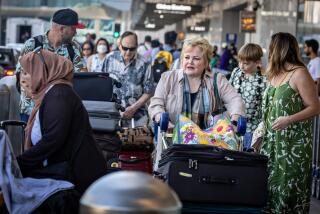TSA follows every move : Covert officers at 161 U.S. airports are trained to pick out suspicious behaviors amid a sea of travelers.
FORT LAUDERDALE, FLA. — You might not see them. But they’re watching you.
To identify dangerous people, the Transportation Security Administration stations behavior-detection officers at 161 U.S. airports, including ones in Miami, Fort Lauderdale and Los Angeles. The officers can be anywhere, from the parking garage to the gate, looking for passengers who seem highly nervous or stressed.
They don’t focus on nationality, race, ethnicity or gender, said TSA spokeswoman Sari Koshetz.
“We’re not looking for a type of person, but at behaviors,” she said.
Under the program, which started in Boston in 2003, a suspicious passenger might be given a secondary security screening or referred to police. Detection officers don’t have the power to arrest someone.
Last year, officers required nearly 99,000 passengers nationwide to undergo additional screenings. Police questioned about 9,900 of them and arrested 813.
In one case, in March 2008, officers noticed a passenger about to board a flight from Fort Lauderdale to Charlotte, N.C. During a secondary screening, officers found an estimated $2.5 million worth of the drug Ecstasy in a carry-on bag. The traveler was arrested.
In other instances, travelers have been arrested on charges of drug trafficking, possessing fraudulent documents and having outstanding warrants, Koshetz said.
In February 2008, detection officers at Miami International Airport noted that a passenger had suspicious travel documents and was acting oddly. When he was flagged for a secondary screening, he bolted.
Police and TSA officers chased the man, who ran out of the terminal and jumped from an elevated road onto a sidewalk. He broke an arm and was arrested on charges of resisting arrest, disorderly conduct and possessing several IDs.
It’s not easy to spot detection officers. Working in teams of two and clad in TSA uniforms, they blend in with those doing the security screenings.
Officers are chosen for their intelligence, maturity and ability to work with people, the TSA said. No background in behavior analysis is required. They undergo four days of behavior training, which includes trying to spot would-be terrorists, then receive 24 hours of on-the-job training.
On a recent day, detection officers Juan and Humberto -- their last names are concealed to protect their covert status -- eyeballed hundreds of passengers at Fort Lauderdale-Hollywood International Airport.
Juan started a friendly conversation with a red-eyed traveler carrying a large case. Such chats allow an officer to learn more about whether someone has malicious intentions, Juan said.
As it turned out, the case contained a music amplifier and the man was simply tired. “He was pretty calm,” Juan said.
Koshetz said the TSA had established specific criteria for what is considered normal behavior “in an airport environment.” She said officers react only when a passenger strays from those guidelines, which the TSA declined to reveal for security reasons.
Alex Archer, of Sunrise, Fla., a businessman on his way to Chicago, said he had no objection to being secretly watched.
“Honestly, I haven’t even noticed them,” he said. “They must be doing a good job. It’s better to have more security than not enough.”
--
More to Read
Sign up for The Wild
We’ll help you find the best places to hike, bike and run, as well as the perfect silent spots for meditation and yoga.
You may occasionally receive promotional content from the Los Angeles Times.






